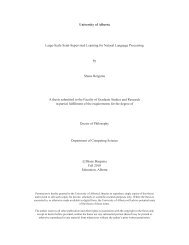The high altitude wildlife areas of western Arunachal Pradesh
The high altitude wildlife areas of western Arunachal Pradesh
The high altitude wildlife areas of western Arunachal Pradesh
You also want an ePaper? Increase the reach of your titles
YUMPU automatically turns print PDFs into web optimized ePapers that Google loves.
<strong>The</strong> Tawang macaque<br />
provisionally identifies them as the Tibetan macaque on the basis <strong>of</strong> their relatively<br />
shorter tail compared to the Assamese macaque, more prominent buffy side-whiskers,<br />
and differences in their vocalisations 3 . Although Choudhury does not provide<br />
measurements or a detailed description, his description somewhat matches that <strong>of</strong> the<br />
Tawang macaque. <strong>The</strong> Tawang macaque, however, has a remarkably dark pelage and<br />
facial skin, and a pale-yellow crown patch shared by all individuals – features not<br />
reported by Choudhury.<br />
Conclusion<br />
What then could be the taxonomic identity <strong>of</strong> the Tawang macaque? Its similarities<br />
with the Assamese and Tibetan macaque suggest that the Tawang macaque<br />
presumably belongs to the same sinica group 5 <strong>of</strong> the genus Macaca as both these<br />
species. At the same time, its distinctive features set the Tawang macaque apart from<br />
either <strong>of</strong> them. We therefore believe that the population <strong>of</strong> the Tawang macaque<br />
reported here potentially represents a distinct species within the sinica group <strong>of</strong> the<br />
genus Macaca. We now propose to conduct more extensive surveys for the taxon and<br />
detailed field studies on the demography, ecology and behaviour <strong>of</strong> different<br />
populations in <strong>Arunachal</strong> <strong>Pradesh</strong>. In addition, we will attempt to collect specimens<br />
for specific morphological and anatomical measurements as well as molecular genetic<br />
analyses in order to facilitate more in-depth comparisons with Assamese and Tibetan<br />
macaques and determine the exact taxonomic position <strong>of</strong> the macaque.<br />
References<br />
1. Fooden, J. (1982) Taxonomy and evolution <strong>of</strong> the sinica group <strong>of</strong> macaques: 3. Species and<br />
subspecies accounts <strong>of</strong> Macaca assamensis. Fieldiana Zoology, 10, 1-52.<br />
2. Sarkar, P. (2000) Ecology and dynamics <strong>of</strong> social relationships <strong>of</strong> the Assamese macaque, Macaca<br />
assamensis (McClelland, 1839). Ph.D. <strong>The</strong>sis Gauhati University, Guwahati, India<br />
3. Choudhury, A. (2002) Survey <strong>of</strong> primates in West Kameng district, <strong>Arunachal</strong> <strong>Pradesh</strong>, India.<br />
ASP Bulletin, 26, 12.<br />
4. Fooden, J. (1983) Taxonomy and evolution <strong>of</strong> the sinica group <strong>of</strong> macaques: 4. Species account<br />
<strong>of</strong> Macaca thibetana. Fieldiana Zoology, 17, 1-20.<br />
5. Fooden, J. (1976) Provisional classification and key to living species <strong>of</strong> macaques (Primates:<br />
Macaca). Folia Primatologica, 25, 225-236.<br />
39

















